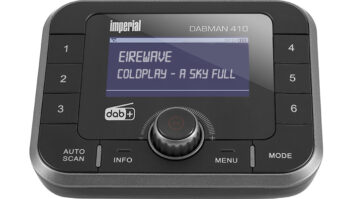Contract engineer Tim Walker says his station’s 1 kW AM transmitter had been in reliable service for 13 years but then went off the air one day, displaying a “High B Minus Voltage” fault. When he reset the fault detector the failure recurred.

Fig. 1: A loose RF ground bolt could keep your transmitter off the air.
Several days of swapping circuit boards and modules and replacing suspect components ensued. But he discovered the culprit when a station employee noticed small arcs as the transmitter was operating. The problem was in the junction between the output network enclosure box and the ground lug bolt, intended to “RF ground” the enclosure securely. This bolt can be seen in Fig. 1. Close examination revealed pitting where the metal surfaces met.
With a turn of less than one-eighth rotation on the companion nut and lock washer, Tim restored the transmitter to reliable service. Sometimes, he concludes, the little pebbles in the roadway are the ones we trip over.
The transmitter in this case was a Nautel ND1, and I remember learning at a Nautel User’s Group session years ago that tightening the hardware in these solid-state transmitters is an important maintenance procedure. This is good advice for equipment of all brands. If you haven’t adopted this maintenance task for all your equipment (transmitters, couplers and phasor components), you should do so.
Loose hardware also can cause AM directional antenna parameter drifting or instability. So before you start cranking on the phasor, make sure all component connections are tight.
****
Crawford Broadcasting Chicago Engineering Manager Rick Sewell recently chronicled an interesting engineering problem in his department’s Local Oscillator newsletter.
Coming back from lunch, Rick noticed that the automatic back gate was stuck open — one more thing to handle before getting to his desk and the real duties of his day.
Before he could even reach the gate, though, a mother duck and eight of her ducklings took advantage of the open gate and wandered into the parking lot, taking up residence under the program director’s car.

Rick needed to close the gate but didn’t want to leave them in the parking lot where they had no food or water supply. He decided to get a broom and chase the ducks out.
If you have tried this, you’re already laughing. It didn’t take long for ducklings to scatter all over the parking lot. Rick even brought in reinforcements in the form of the rest of the engineering crew plus a production staff member — all literally herding ducks.
They decided to grab the ducklings to get them into a box because even those that were shooed outside of the fenced parking lot kept coming back in to try to find their mother. And Mama was not even inside the fence any longer because she was too busy dive-bombing everyone as they tried to rescue her babies. For some reason, a couple of other species of birds took turns diving after the staff as well.
Ultimately all eight ducklings were reunited with Mama outside the fence. Hopefully, that’s where they will stay.
Rick’s story suggests a new category for our Broadcast Engineering Badge program: Radio Duck Herding.
****
And while we’re on the subject of Engineering Experience Badges, TV Studio Supervisor Brian Urban of Austin Community College writes to suggest another, gleaned from his contract engineering years: a badge for successfully moving “x” number of studios in just “y” number of days because someone forgot to (a) renew a lease, (b) change the move-in date when the construction completion date changed, (c) inform the engineer that the building had been sold and the premises must be vacated in “y” days or (d) any similar circumstance. Many of us can say “Been there, done that.”
We’ll call this the Radio Get Moving Badge.
****

Jameco’s mixed signal oscilloscope is for use with your iPhone, iPad or iPod.
Frank Hertel, engineering consultant at Newman Kees RF Measurements and Engineering, found an interesting application sold by Jameco. It’s a mixed signal oscilloscope app for the iPhone, iPod or iPad designed by Oscium.
The touch interface of your Apple device represents a viable alternative to traditional knob-based oscilloscopes. The app’s software allows you to pinch the screen to zoom into a waveform, just like you do with a picture. The software is intuitive so you don’t have to spend your time fumbling with oscilloscope settings. Retail price is $399.95, which includes oscilloscope hardware, two 1x/10x analog probes, slotted screwdriver, four analog tip covers, logic harness (four digital + 1 ground) and SMD grabbers.
For more information, enter part number 2225246 in the search field at www.jameco.com.
****
It’s the time of year when the subject of budgets comes up around the station.
Budgets include not just cap-ex but staff salaries; and in the last two weeks alone, I’ve had three engineers tell me their positions had been cut to part-time or eliminated altogether.
Personally, I think station management too often does not evaluate such situations fully. They want to save money; yet a station can have the best talent and the greatest sales people but still be dead in the water if it goes off the air.
Unfortunately, I think such cuts sometimes occur because the engineer has done his or her job too well. The station has had zero off-air time; there are no complaints from air staff that equipment is broken; the sales computers all work flawlessly. Do we really need an engineer when things are running so smoothly?
Managers, I hope you will realize the role your engineer plays in keeping things running well and legally. This doesn’t happen by itself.
Engineers, a suggestion: Prepare a brief, one-paragraph weekly report and send a copy to every department head. This comes back to promoting what you and your department do to keep the station on the air and legal. Funny how those aspects of the operation are forgotten or taken for granted by some managers when they see an engineer’s salary that could be eliminated. Many GMs haven’t a clue about what it takes to keep stations running technically; if we don’t inform them, they will never know.
What do you put in the report? Go back through your email “Sent” folder for ideas of what you did the previous week. Be proactive. If you worked at the transmitter site all night, leave everyone an email or voicemail so they know what you did and where you are (hopefully getting some sleep). The same is true if you work over the weekend. Engineering is not a 9-to-5 job. Does your management know that?
If you’ve developed other successful strategies to highlight your work and protect your job, send them to me at [email protected]. Let’s cut this cancer out right now.
Contribute to Workbench. You’ll help your fellow engineers and qualify for SBE recertification credit. Send Workbench tips to [email protected]. Fax to (603) 472-4944.
Author John Bisset has spent 46 years in the broadcasting industry and is still learning. He handles West Coast sales for the Telos Alliance. He is SBE certified and a past recipient of the SBE’s Educator of the Year Award.







